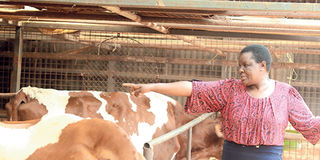I ditched cane for cows, now I’m a happy farmer

Edith Kadali, a dairy farmer in her four-acre farm in Lubeyo Village, Bungoma County. Her farm boosts of a herd of 11 dairy cows; a mixture of Ayrshire and Friesian breeds, that produce 100 litres daily. PHOTO | PHYLLIS MUSASIA | NMG
What you need to know:
- In 2009, Edith took a leap of faith and tried her hand in dairy farming, starting with one Zebu cow, and she has never looked back since then.
- An animal should feed 3 per cent of its body weight for dry feeds and wet feeds should be 10 per cent. If you use this formula, then you save on cost of production.
- She does most of the farm work, with the help of one worker. Each morning, she starts with cleaning the shed and feeding and water troughs.
For close to a decade, Edith Kadali was growing sugar cane on her four-acre farm in Lubeyo village, Bungoma County.
The farmer, 47, would harvest the produce and supply to Nzoia Sugar Company. Life was good.
But challenges started to hit the industry; delayed payments became the norm and frustrations set in for her and hundreds of other farmers in Bungoma and the nearby Mumias, the main cane growing regions in western.
“I would make some Sh91,000 from cane, money that would come after years. This did not make economic sense to me,” she says.
In 2009, Edith took a leap of faith and tried her hand in dairy farming, starting with one Zebu cow, and she has never looked back since then.
The cow produced two litres in a day. Disappointed, she sought help from county livestock officers, who advised her to plant fodder crops that include maize, napier, sunflower and Brachiaria grass for her cows.
“I leased four acres and planted the crops, which I still do to date,” says the farmer, who is a member of Fwebene Women Group that has benefited from training from Smallholder Dairy Commercialisation Programme, run by government and donors.
Her farm currently boosts of a herd of 11 dairy cows, a mixture of Ayrshire and Friesian breeds, that produce 100 litres daily.
REQUIRES A RIGHT ATTITUDE TO ENJOY IT
“I milk five cows. My top producer, an Ayrshire, offers 28 litres of milk a day. The secret to good production is in management and feeding,” says the farmer, whose has ensured each of her animal sleeps on a mat that she bought at Sh7,500 each. She feeds them on silage, hay and dairy meal depending on the animal’s body weight.
“An animal should feed 3 per cent of its body weight for dry feeds and wet feeds should be 10 per cent. If you use this formula, then you save on cost of production,” she says.
She sells her milk to various hotels in her locality and neighbours at Sh60 per litre.
In a good month, she earns Sh120,000 in total, with the money coming from milk sales.
“I have been able to educate my four children, two in college and two in secondary school through dairy farming. I bank money from the farm, which enables me to get loans,” observes Kadali.
She does most of the farm work, with the help of one worker. Each morning, she starts with cleaning the shed and feeding and water troughs.
“Dairy farming is not that labour intensive especially if you find it a satisfying job. It only requires the right attitude and you will enjoy doing it,” says Edith, who is targeting to milk 150 litres per day in the near future by growing her brood.
Paul Otieno, the deputy livestock production officer at Bungoma County, says that with dairy farming, a farmer is in-charge of the production and marketing of his produce, therefore, it offers more income than cane.
He advises farmers to invest in fodder to reduce cost of production. “Feeds contribute to 70 per cent of the cost of production. But farmers can lower this by growing on-farm fodder and pasture as well as supplements such as sunflower and cotton seed cake.”





